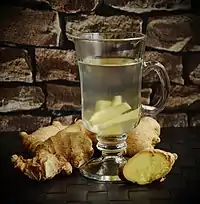Ginger tea
Ginger tea is a herbal beverage that is made from ginger root. It has a long history as a traditional herbal medicine in East Asia, South Asia, Southeast Asia and West Asia.[1]
| Ginger tea | |
|---|---|
 | |
| Type | Herbal tea |
| Other names |
|
| Origin | Asia |
| Quick description | Tea made from ginger |
| Temperature | 100 °C (212 °F) |
| Time | Varies |
| Regional names | |||||||||||||
|---|---|---|---|---|---|---|---|---|---|---|---|---|---|
| Chinese name | |||||||||||||
| Traditional Chinese | 薑母茶 | ||||||||||||
| Simplified Chinese | 姜母茶 | ||||||||||||
| Literal meaning | ginger mother (mature ginger) tea | ||||||||||||
| |||||||||||||
| Korean name | |||||||||||||
| Hangul | 생강차 | ||||||||||||
| Hanja | 生薑茶 | ||||||||||||
| Literal meaning | ginger tea | ||||||||||||
| |||||||||||||
| Japanese name | |||||||||||||
| Kanji | 生姜湯 | ||||||||||||
| Kana | しょうがゆ | ||||||||||||
| |||||||||||||
| Malay name | |||||||||||||
| Malay | teh halia | ||||||||||||
| Indonesian name | |||||||||||||
| Indonesian | teh jahe | ||||||||||||
| Filipino name | |||||||||||||
| Tagalog | salabat | ||||||||||||
Regional variations and customs
Ginger tea can be drunk by itself, or served alongside traditional accompaniments, such as milk, orange slices, or lemon.[2][3]
 Lemon ginger tea
Lemon ginger tea
China
In the Tang dynasty, tea was flavoured to counteract the bitter taste. Ginger was favoured among tea drinkers, in addition to onion, orange peel, cloves and peppermint.[4]
Japan
In Japan, it is called shōgayu (生姜湯).[5]
Korea
In Korea, ginger tea is called saenggang-cha (생강차; 生薑茶, [sɛ̝ŋ.ɡaŋ.tɕʰa]). It can be made either by boiling fresh ginger slices in water or mixing ginger juice with hot water.[6] Sliced ginger preserved in honey, called saenggang-cheong, can also be mixed with hot water to make ginger tea.[7] Nowadays, powdered instant versions are also widely available.[8] When served, the tea is often served garnished with jujubes and pine nuts.[9] When using fresh ginger, the tea can be sweetened with honey, sugar, or other sweetener according to taste.[6] Garlic, jujubes, and pear are sometimes boiled along with ginger.[6]
Brunei, Malaysia, Singapore
In Brunei, Malaysia and Singapore cuisines, ginger tea is usually called teh halia.[10] It is not a pure ginger tea, as it is brewed of strong sweetened black tea with milk or condensed milk.
.jpg.webp) Teh halia (Singaporean ginger tea)
Teh halia (Singaporean ginger tea)
Indonesia
In Indonesia, it is called teh jahe. In Java, a local version of ginger tea enriched with palm sugar and spices called wedang jahe is more popular.[11]
Wedang Jahe is a type of Indonesian ginger tea.[11] Wedang in Javanese means "hot beverage" while jahe means "ginger". Although devoid of any caffeine content, it is often served and enjoyed as an invigorating tea. It is made from ginger rhizome, usually fresh and cut in thin slices, and palm sugar or granulated cane sugar, frequently with the addition of fragrant pandan leaves. Palm sugar can be substituted with brown sugar or honey. Traditionally people might add spices such as lemongrass, cloves, and cinnamon stick.[11]
Milk, either fresh or condensed, might be added.[12]
 Wedang jahe (Javanese ginger tea) in Surakarta, Central Java, with bits of spices
Wedang jahe (Javanese ginger tea) in Surakarta, Central Java, with bits of spices
Philippines
In the Philippines, it is called salabat and usually served in the relatively cold month of December.[13]
 Salabat from Pampanga
Salabat from Pampanga
India
In India, ginger tea is known as Adrak ki chai and is a widely consumed beverage. It is made by grating ginger into brewed black tea along with milk and sugar
 Adrak chai (Indian ginger tea)
Adrak chai (Indian ginger tea)
See also
- Ginger ale
- Ginger beer
- Traditional Korean tea
- Bajigur
- Bandrek
- List of hot beverages
- List of Indonesian beverages
- Tisane (herbal tea)
References
- "Ginger (Overview)". University of Maryland Medical Center. 22 June 2015. Retrieved 21 March 2016.
- "Ginger Tea with Orange Slices". Daytona Beach Morning Journal. 29 October 1971. Retrieved 22 March 2016.
- "Lemon Ginger Tea". The Evening News. 18 May 1988. Retrieved 22 March 2016.
- Heiss, Mary; Heiss, Robert (2011). The Story of Tea: A Cultural History and Drinking Guide. A Brief History of Tea: Ten Speed Press. ISBN 978-1-60774-172-5. Retrieved 24 August 2019.
- Martha Stone (23 February 2015). Japanese Cookbook: The Traditional and Simple Japanese Cuisine. Martha Stone. pp. 1–. GGKEY:H99J4YXSAAL.
- "Saenggang-cha" 생강차. Doopedia (in Korean). Retrieved 23 October 2009.
- Agbor, Nnehkai (16 March 2017). "8 Healthy Korean Teas To Enjoy Throughout The Year". 10 Magazine. Retrieved 29 December 2017.
- The Korea Foundation, ed. (2004). Korean Food Guide in English. Seoul: Cookand / Best Home Inc. ISBN 89-89782-10-4. Retrieved 29 December 2017.
- Parker, Ann (23 August 2016). "Sushi San, Restaurant Review: New sushi spot transforms former Felton home of Mama Mia's". Santa Cruz Sentinel. Archived from the original on 29 December 2017. Retrieved 29 December 2017.
- "Plen-tea-ful uses". Daily Express. 11 November 2015. Retrieved 22 March 2016.
- Pepy Nasution (12 February 2010). "Wedang Jahe (Indonesian Ginger Tea)". Indonesia Eats.
- Anita (5 August 2013). "Wedang Teh Susu Jahe – Ginger Milk Tea". Daily Cooking Quest.
- Caroline Joan Picart (January 2004). Inside Notes from the Outside. Lexington Books. pp. 48–. ISBN 978-0-7391-0763-8.



